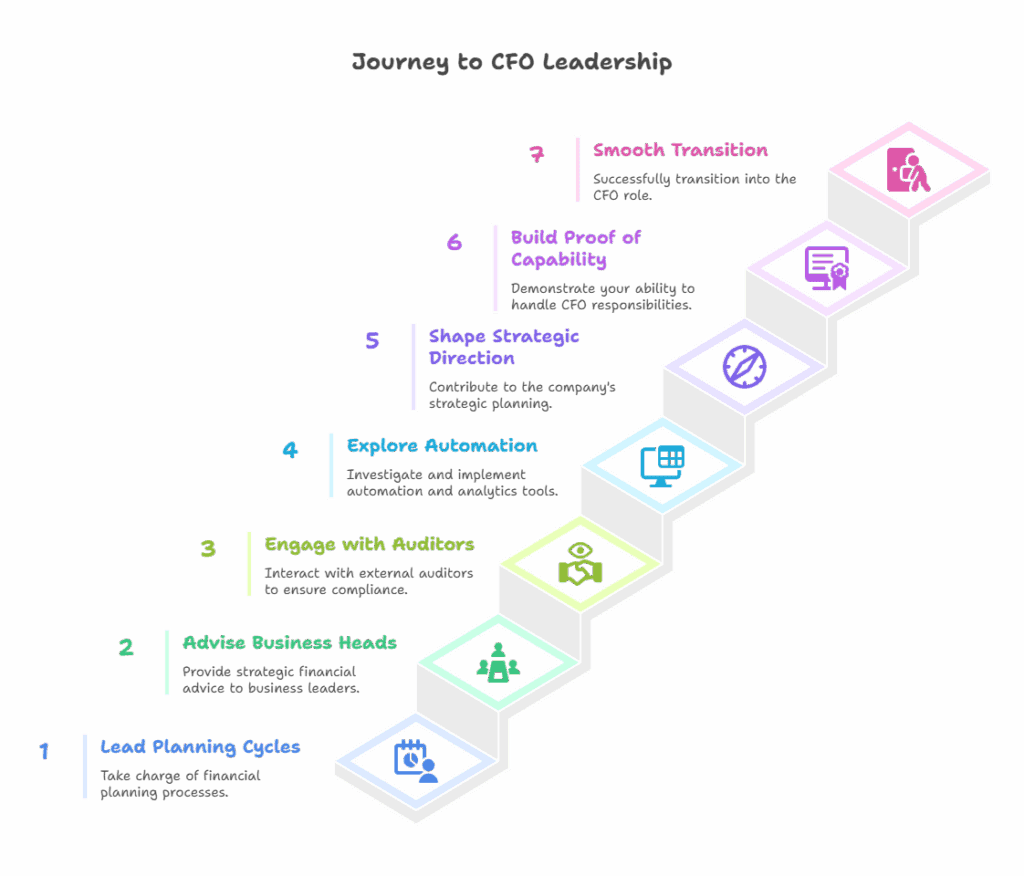Financial analysis is the systematic examination of a company’s financial data to assess its performance and financial health. CFOs scrutinise financial statements, budgets, and projections to uncover trends, strengths, weaknesses and opportunities for this strategic process. CFO financial analysis is instrumental in informing strategic decision-making, risk assessment and resource allocation.
The CFO occupies a pivotal role in safeguarding and enhancing a company’s financial well-being. CFO financial analysis involves overseeing financial operations, managing cash flow, and ensuring financial compliance. A deep understanding of the company’s financial health is essential for the CFO to make informed decisions that drive sustainable growth and profitability.
In this article, I will discuss the critical role of CFO financial analysis in empowering businesses to make strategic decisions. We will explore the core concepts of CFO financial analysis, its application in evaluating business performance, and its contribution to overall organisational success.
Understanding Financial Statements
Financial statements are the cornerstone of a company’s financial health, providing a comprehensive view of its performance and position. In this section, we will delve into the three primary financial statements, the balance sheet, income statement and cash flow statement to equip you with a robust understanding of their components, interrelationships and analytical techniques. By mastering these financial tools, we can make informed decisions, assess business performance, and identify opportunities for improvement.
Let us explore each statement in detail, uncovering insights into a company’s financial structure, profitability, and cash management practices.
The Balance Sheet
The balance sheet is a financial snapshot outlining a company’s assets, liabilities, and shareholders’ equity. Assets are resources owned, liabilities are obligations, and shareholders’ equity represents ownership claims. These components are interconnected. Assets are financed by a combination of debt (liabilities) and equity. Understanding this interplay is crucial for financial analysis.
Beyond basic ratios like the current ratio and debt-to-equity ratio, advanced techniques offer deeper insights. DuPont analysis deconstructs return on equity into profitability, asset turnover, and financial leverage components. Common-size analysis expresses balance sheet items as percentages of total assets, enabling comparison across companies or time periods.
Comparing companies with strong and weak balance sheets highlights key differences. Strong balance sheets often exhibit higher liquidity, lower leverage, efficient asset utilisation, and substantial shareholder equity. Conversely, weak balance sheets may reveal liquidity concerns, excessive debt, asset impairment, and diluted ownership. By dissecting these variations, CFO financial analysis can identify areas for improvement and implement CFO financial strategies to strengthen the financial position of the CFO’s company.
The Income Statement
The income statement provides a financial summary of a company’s profitability over a specific period. It outlines revenues generated from core operations and other sources, along with expenses incurred to generate those revenues. Key components include sales revenue, cost of goods sold (COGS), operating expenses, interest expense, taxes, and net income. Understanding the interplay between these elements is crucial for assessing a company’s financial health.
A deeper profitability analysis involves scrutinising specific metrics. Gross profit margin measures the profitability of core operations by comparing gross profit to net sales. The operating profit margin reveals profitability before interest and taxes, indicating the efficiency of core business activities. By meticulously analysing these margins over time and compared to industry benchmarks, CFOs can identify trends, strengths, and areas for improvement.
Uncovering hidden profit leaks requires a thorough examination of the income statement. This involves identifying cost overruns, inefficiencies, or revenue leakage. By scrutinising expense categories, comparing costs to industry standards, and benchmarking performance, CFO financial analysis can pinpoint opportunities to reduce costs, increase revenues, and enhance overall profitability.
The Cash Flow Statement
The cash flow statement provides a dynamic view of a company’s cash inflows and outflows. It’s divided into three primary sections: operating, investing, and financing activities. Operating activities reflect cash generated or used in core business operations. Investing activities involve cash flows related to asset purchases or sales. Financing activities pertain to cash raised from or repaid to investors and creditors. Understanding the interplay between these activities is crucial for assessing a company’s liquidity and financial health.
Effective cash flow management requires accurate forecasting and strategic planning. By analysing historical cash flow data, identifying trends, and considering future business plans, CFO financial analysis can create robust cash flow forecasts. These forecasts help CFOs in anticipating cash shortages or surpluses, enabling proactive measures such as optimising working capital, managing inventory levels, and securing financing when needed.
Case studies of companies experiencing cash flow crises and those successfully navigating challenges offer valuable lessons. Examining factors contributing to cash flow difficulties, such as rapid growth, economic downturns or operational inefficiencies, helps us identify potential risks. Conversely, analysing successful turnaround stories reveals CFO financial strategies for improving cash flow generation, reducing expenses, and optimising working capital.
Key Financial Ratios and Metrics
While foundational financial ratios provide valuable insights, a deeper dive into advanced metrics is essential for a comprehensive understanding of a company’s financial health and performance. In this section, we will explore a range of key performance indicators (KPIs) and less commonly used ratios that can offer critical insights for strategic decision-making. By effectively utilising these tools, CFO financial analysis can navigate complexities, identify potential risks, and drive sustainable growth.
Advanced Ratio Analysis
Beyond commonly used ratios, a deeper dive into advanced metrics offers invaluable insights. The cash conversion cycle measures the time it takes to convert inventory into cash, highlighting operational efficiency. Return on invested capital (ROIC) assesses the profitability of capital invested in a business. These metrics, along with others, provide us a more nuanced understanding of a company’s financial performance.
Ratios are powerful tools for identifying potential financial distress. Deteriorating trends in profitability, liquidity, or solvency ratios can signal early warning signs. By closely monitoring these metrics, CFOs can proactively address issues before they escalate.
Benchmarking against industry peers and best-in-class companies reveals a company’s relative performance. Identifying areas where a company excels or lags behind competitors can inform strategic decision-making and drive performance improvement.
Key Performance Indicators (KPIs) for CFOs
Key Performance Indicators (KPIs) are quantifiable metrics used to measure a company’s performance against its strategic objectives. CFOs play a pivotal role in selecting, tracking, and analysing KPIs to assess financial health, operational efficiency, and overall business success.
A comprehensive KPI dashboard provides a centralised view of critical metrics. Looking at business financial health indicators allows CFOs to monitor performance trends, identify areas for improvement, and make data-driven decisions. The dashboard should include a mix of financial and non-financial KPIs, tailored to the specific goals of the organisation.
Aligning business financial health indicators with strategic objectives is essential for ensuring that performance measurement supports the company’s overall direction. By cascading KPIs down through the organisation, CFO financial analysis can foster accountability and drive performance improvement at all levels.
Financial Analysis for Investment Evaluation
Sound investment decisions hinge on rigorous financial analysis. This section delves into the core techniques and methodologies employed by investors to evaluate investment opportunities. From the foundational discounted cash flow (DCF) model to alternative valuation approaches, readers will gain a comprehensive understanding of the tools necessary to make informed investment choices. By mastering these CFO financial analysis techniques and applying them to real-world case studies, investors can enhance their decision-making capabilities and optimise investment returns.
DCF Modeling
Discounted Cash Flow (DCF) models project a company’s future cash flows and discount them back to present value to estimate its intrinsic worth. Building a robust DCF requires meticulous forecasting of revenue, expenses, capital expenditures, and working capital. Key components of this type of CFO financial analysis include projecting free cash flow, determining the appropriate discount rate, and calculating the terminal value.
Sensitivity analysis examines how changes in key assumptions impact the valuation. Scenario planning creates multiple valuation scenarios based on different economic or business conditions. These CFO financial analysis techniques help assess valuation robustness and identify potential risks.
DCF models can be applied to various investments. For stocks, the model values the entire company. For bonds, cash flows represent interest payments and principal repayment. Real estate DCFs focus on rental income, operating expenses, and property appreciation. Adapting the DCF framework to specific investment types is crucial for accurate valuation.
Alternative Valuation Methods
Relative valuation compares a company’s value to similar publicly traded companies. This type of CFO financial analysis involves calculating valuation multiples like price-to-earnings (P/E) ratio, price-to-book (P/B) ratio, or enterprise value-to-EBITDA (EV/EBITDA). By benchmarking against comparable companies, investors can assess whether a company is undervalued or overvalued.
Real options analysis recognises that businesses often possess options to undertake future projects or investments. It values these options by considering factors like uncertainty, time value of money, and decision points. This method is particularly useful for valuing companies with growth opportunities or in industries with high levels of uncertainty.
Studying case studies of successful and failed investments provides valuable lessons. Analysing factors contributing to successful investments, such as thorough due diligence, accurate valuation, and effective risk management, helps investors replicate winning CFO financial strategies. Conversely, examining failed investments reveals common pitfalls and teaches investors how to avoid costly mistakes.
Financial Analysis for Project Evaluation
Sound project evaluation is the bedrock of successful investment decisions. This section delves into the critical methodologies and techniques employed to assess project feasibility and profitability. From traditional capital budgeting methods to advanced financial modelling, readers will gain a comprehensive understanding of the tools necessary to make informed project decisions. By mastering these techniques and applying them to real-world scenarios, businesses can optimise resource allocation and maximise returns on investment.
Advanced Project Appraisal Techniques
Capital budgeting techniques are essential for evaluating project viability. Net Present Value (NPV) calculates the present value of future cash flows, determining project profitability. Internal Rate of Return (IRR) identifies the discount rate at which NPV equals zero. The payback period measures the time required to recover the initial investment. These methods provide valuable insights into project returns and risks.
Incorporating risk and uncertainty is crucial for accurate project evaluation. Sensitivity analysis examines how changes in key variables impact project outcomes. Scenario analysis creates multiple project scenarios based on different assumptions. These techniques help assess project resilience and potential downside risks.
Real-world projects often involve complexities and uncertainties. Analysing successful projects highlights effective decision-making processes, risk mitigation strategies, and financial performance. Studying failed projects reveals common pitfalls, such as underestimated costs, overestimated revenues, or unforeseen risks. These case studies offer valuable lessons for future project evaluations.
Financial Modeling for Project Feasibility
A comprehensive financial model is a cornerstone of project evaluation. It provides a detailed projection of a project’s financial performance, including revenues, costs, and cash flows. Building a robust model requires careful consideration of various factors such as market size, pricing strategy, operational expenses, and capital expenditures.
Accurate forecasting of revenues, costs, and cash flows is crucial for model reliability. This involves analysing market trends, competitor pricing, cost structures, and potential growth opportunities. By incorporating realistic assumptions, financial models can provide a clear picture of the project’s expected financial performance.
Sensitivity analysis is essential for assessing project viability under different economic conditions. By varying key assumptions, such as sales volume, unit price, or cost of goods sold, analysts can identify potential risks and opportunities. This CFO financial analysis helps determine the project’s resilience to unforeseen challenges and its potential for generating positive returns.
You can enrol in a holistic CFO course to learn more about CFO financial analysis for project feasibility.
Financial Analysis and Risk Management
Financial analysis is not merely about understanding a company’s performance, it is equally about anticipating and mitigating potential threats. This section delves into the critical aspects of financial risk management, from identifying and assessing risks to implementing robust fraud prevention measures. By understanding these CFO financial analysis concepts, businesses can build resilience, protect their assets, and make informed decisions in an increasingly complex financial landscape.
Identifying and Assessing Financial Risks
Financial risks are potential threats to a company’s financial stability. Key categories include market risk, credit risk, and operational risk. Market risk arises from fluctuations in interest rates, exchange rates, or commodity prices. Credit risk stems from the possibility of customers or counterparties defaulting on their obligations. Operational risk encompasses losses due to internal or external factors disrupting business operations.
Effective risk management involves identifying potential risks, assessing their impact and likelihood, and developing appropriate mitigation strategies. Tools such as risk assessments, sensitivity analysis, and stress testing help quantify and prioritise risks. Diversification, hedging, insurance, and internal controls are common risk management techniques.
Case studies of companies that successfully navigated financial crises highlight the importance of proactive risk management. These companies often had robust risk assessment processes, early warning systems, and contingency plans in place. By learning from their experiences, organisations can strengthen their risk management practices and build resilience.
Fraud Detection and Prevention
Financial fraud poses a significant threat to businesses. Recognising red flags is crucial for early detection. Unusual transactions, discrepancies in records, unexplained assets, or employee lifestyle changes might indicate fraudulent activities. Implementing robust internal controls is essential to safeguard assets. Segregation of duties, authorisation and approval processes, regular reconciliations, and access controls deter fraudsters.
Effective fraud investigation and prevention involve a multi-faceted approach. Conducting thorough investigations, preserving evidence, and collaborating with law enforcement are crucial steps. Implementing employee training programs, promoting a strong ethical culture, and staying updated on fraud trends help prevent and detect fraudulent activities.
Financial Analysis for Strategic Decision-Making
Financial analysis is not merely a retrospective exercise, it is a powerful tool for shaping a company’s future.
In this section, we will explore the symbiotic relationship between finance and strategy, demonstrating how financial insights can drive strategic decision-making. By aligning financial goals with overarching business objectives, organisations can optimise resource allocation, enhance profitability, and achieve sustainable growth.
Financial Analysis and Business Strategy
Financial goals and overall business strategy should be intrinsically linked. Financial objectives like profitability, growth, and shareholder value creation must align with the company’s broader mission and vision. This alignment ensures that financial resources are allocated effectively to support strategic priorities.
CFO financial analysis provides critical insights to inform strategic decision-making. By evaluating performance metrics, identifying trends, and assessing financial risks, companies can make informed choices about market entry, product development, acquisitions, and resource allocation. This data-driven approach enhances the likelihood of successful strategy execution.
Numerous companies have leveraged financial analysis to achieve strategic breakthroughs. By identifying untapped market opportunities, optimising cost structures, and measuring the financial impact of strategic initiatives, these organisations have gained a competitive edge. Case studies of these companies offer valuable lessons for other businesses seeking to harness the power of CFO financial analysis for strategic advantage.
Financial Analysis for Mergers and Acquisitions
Mergers and acquisitions require meticulous financial analysis. Valuation involves determining a target company’s fair value using methods like discounted cash flow, comparable company analysis, or precedent transactions. Due diligence is a comprehensive examination of the target’s financial health, operations, legal matters, and potential liabilities. This CFO financial analysis process helps identify risks and opportunities and informs negotiation strategies.
Post-merger integration is a complex process requiring careful financial planning. Combining financial systems, aligning accounting practices, and optimising cost structures are critical. Financial performance analysis is essential to assess the deal’s success by tracking key metrics like revenue growth, cost synergies, and return on investment.
Successful mergers and acquisitions are characterised by thorough due diligence, effective integration, and realisation of synergies. Conversely, failed deals often stem from overpaying, integration challenges, or cultural clashes. By analysing case studies, companies can learn from both successes and failures to improve their M&A execution capabilities.
Wrapping Up
The field of financial analysis is continually evolving, driven by technological advancements and changing business landscapes. The integration of artificial intelligence and big data is transforming how financial data is analysed, interpreted, and utilised. This trend necessitates a shift in the CFO’s role towards strategic leadership and data-driven decision-making.
To navigate the complexities of the modern business environment, CFOs must possess a deep understanding of financial analysis principles. By mastering the CFO financial analysis techniques and tools discussed in this article, CFOs can enhance their ability to assess financial performance, make informed strategic choices, and mitigate risks. Embracing a data-driven culture and staying abreast of emerging trends are essential for future success.
If you wish to become a CFO, you can enrol in the Indian School of Business and Imarticus Learning’s Chief Financial Officer Programme to become a highly-skilled CFO. This comprehensive CFO course will teach you everything you need to know to have a solid career in this field.
Frequently Asked Questions
What is the importance of CFO financial analysis for a business?
CFO financial analysis is crucial for understanding a company’s financial health, making informed decisions, and identifying areas for improvement. It helps in budgeting, forecasting, and evaluating investment opportunities.
How can financial analysis help in making strategic decisions?
By providing insights into financial performance, trends, and risks, CFO financial analysis aids in identifying growth opportunities, optimising resource allocation, and evaluating potential mergers or acquisitions.
What are the key components of a financial model?
A financial model typically includes revenue projections, cost estimates, capital expenditures, financing assumptions, and cash flow forecasts. It serves as a tool for evaluating the financial feasibility of a project or business venture.
How can CFOs leverage financial analysis for better decision-making?
CFOs can use financial analysis to monitor financial performance, identify trends, assess risks, and make data-driven decisions. By aligning financial goals with business objectives, CFO financial analysis can contribute significantly to overall strategic success.













